| See Issue Online | Archive |

|
|
October 2013 | Issue 74
|
Forward to a Friend |
Subscribe
|
Dear <<First Name>>,
October is upon us, the countdown to the end of the year - and we should take a moment to wish our Australian and Indian friends well through their trials with both man-made and natural disasters as of late; we hope you and your families and parrot companions are able to cope and stay safe. As for our newsletter, here it is, and it is chock-full of news and advice for your reading enjoyment! We have a new podcast on enrichment, news about Congo Grey parrots from researcher Dr. Therese Hart and TL2, releases of macaws back to the wild, an opportunity for intrepid readers to volunteer in the field, and more. So have a look, learn new things, and enjoy!
Desi Milpacher, Flock Talk editor

In This Issue
2014 WPT Parrot Calendars
Order now for Christmas
|
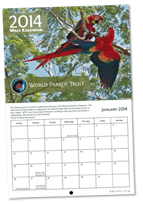 They are here! The World Parrot Trust's very own calendar is back - enjoy stunning photos of wild parrots year round! Learn more about WPT's work with informative text that accompanies the many endangered parrot species featured, including: Lear's Macaw, Vinaceous Amazon, Blue-fronted Amazon, Timneh Parrot, Cape Parrot, Blue-throated Macaw, Scarlet Macaw and more - parrot representatives from all across the globe.
All sale proceeds support the WPT's work to save wild parrots. Order yours now, and help us continue our important work!
They are here! The World Parrot Trust's very own calendar is back - enjoy stunning photos of wild parrots year round! Learn more about WPT's work with informative text that accompanies the many endangered parrot species featured, including: Lear's Macaw, Vinaceous Amazon, Blue-fronted Amazon, Timneh Parrot, Cape Parrot, Blue-throated Macaw, Scarlet Macaw and more - parrot representatives from all across the globe.
All sale proceeds support the WPT's work to save wild parrots. Order yours now, and help us continue our important work!
Place your order today »
|
Species Profile:
Senegal Parrot
|
Genus: Poicephalus
Species: senegalus
World Population: Not recorded
Range:
P.s. senegalus: W African dry belt, from S Mauritania, Senegal, Guinea, including Los Islands and S Mali east to S Burkina Faso and N Nigeria.
P.s. versteri: W African wet zone, north of rainforest belt to lat 9N from Liberia (introduced to Monrovia district) and Ivory Coast east to W Nigeria.
P.s. mesotypus: E and NE Nigeria, to N Cameroon, south to Adamawa Plateau, SW Chad, and possibly NE Central African Republic.
Habitat:
Found in wide range of wooded areas from open farmland with scattered trees to closed-canopy forests. Seen up to 1200m (3936ft).
Ecology:
Mostly sedentary, but will visit rainy areas. Usually found below 1000m (3280 ft). Social outside breeding season. Usually seen in pairs but also in flocks up to 20 or more while feeding. Takes fruit, buds, seeds; also crop items such as millet and peanuts.
Threat Summary:
Heavily traded. Between 2000 and 2003 over 100,000 were exported from countries across West Africa (Gilardi 2006).
IUCN/CITES Rating: Least concern, Appendix II
Learn more about the Senegal Parrot »
|

|
Grey Parrot Report from Central DRC
Dr. Therese Hart, TL2 Project
|
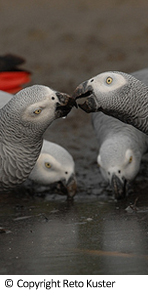
|
Dr. Therese Hart, director of the TL2 Project (Tshuapa, Lomami and Lualaba rivers) heads a team of 30-40 dedicated staff and field biologists sprinkled across three provinces of central Democratic Republic of the Congo (DRC). They began their survey in 2007 with a mandate to explore and document the species of an unknown 40,000 square km pocket in the middle of the country. Along the way they encountered Grey Parrots, and shared with us their thoughts on the birds' pressures and prospects in the area.
Read the blog »
|
Teaching Parrots to Forage
New Podcast by Kris Porter
|
 Kris Porter specializes in enrichment for parrots, and is best known for her Parrot Enrichment Activity books, which she has made freely available to parrot caregivers for many years. Her books are full of photographs, suggestions and ideas to enrich the lives of parrots and promote activity rather than stillness. Kris Porter specializes in enrichment for parrots, and is best known for her Parrot Enrichment Activity books, which she has made freely available to parrot caregivers for many years. Her books are full of photographs, suggestions and ideas to enrich the lives of parrots and promote activity rather than stillness.
A graduate of Susan Friedman's behaviour course "Living and Learning with Parrots", Kris serves as an online Expert for the World Parrot Trust, and has had numerous articles on the subject featured in such publications as Good Bird Magazine, Parrots Magazine and Australian BirdKeeper. Her latest effort is 'Teaching Parrots to Forage', a podcast that details food-exploring opportunities that can spice up a companion parrot's life, so have a listen!
Listen now »
|
|
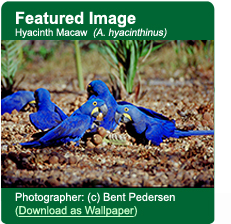



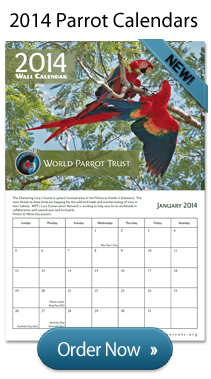
 |  | Test Your Parrot IQ
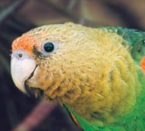
1. This parrot is from Africa. Name it.
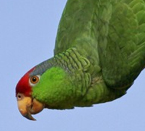
2. This Amazon has established populations in
the US. What is it?
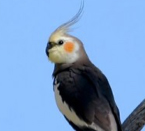
3. This little parrot is common in the wild. Name it.
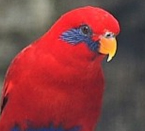
4. This parrot feeds on nectar and flowers. What is it?
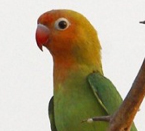
5. This tiny parrot is Near-threatened in the wild. Name it.
(Click photos above for
the answers.)
For more information »
Also visit our photostream
at Flickr »
|
 |

|
|
New WPT Staff, Dr. Rowan Martin
WPT African Conservation Programme Project Manager
|
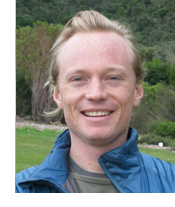 WPT is growing to meet the challenges of parrot conservation! We are pleased to welcome Dr. Rowan Martin to our staff. He will be the managing the WPT Africa Conservation Programme (WPT-ACP), a hefty job as he will be doing a great deal indeed: he'll be leading the development, management, and implementation of the programme, promoting its vision and objectives to external and WPT partners, and participating in strategic partnership-building and fundraising approaches, supervising WPT-ACP related projects, and providing technical assistance as required. Dr. Martin first became involved with WPT during his doctoral studies on the breeding behaviour of Yellow-shouldered Amazon parrots on Bonaire when he was based at the University of Sheffield, UK. Between 2009 and 2013 he held a Postdoctoral fellowship at the Percy FitzPatrick Institute of African Ornithology at the University of Cape Town, South Africa. While in South Africa he became involved in African parrot conservation, co-ordinating a review of the state of research and conservation in parrots in Africa for the International Ornithologist's Union Parrot Researcher's Group. The findings of this review provide a road map for the WPT Africa Conservation Programme.
WPT is growing to meet the challenges of parrot conservation! We are pleased to welcome Dr. Rowan Martin to our staff. He will be the managing the WPT Africa Conservation Programme (WPT-ACP), a hefty job as he will be doing a great deal indeed: he'll be leading the development, management, and implementation of the programme, promoting its vision and objectives to external and WPT partners, and participating in strategic partnership-building and fundraising approaches, supervising WPT-ACP related projects, and providing technical assistance as required. Dr. Martin first became involved with WPT during his doctoral studies on the breeding behaviour of Yellow-shouldered Amazon parrots on Bonaire when he was based at the University of Sheffield, UK. Between 2009 and 2013 he held a Postdoctoral fellowship at the Percy FitzPatrick Institute of African Ornithology at the University of Cape Town, South Africa. While in South Africa he became involved in African parrot conservation, co-ordinating a review of the state of research and conservation in parrots in Africa for the International Ornithologist's Union Parrot Researcher's Group. The findings of this review provide a road map for the WPT Africa Conservation Programme.
Dr. Martin is an ecologist with a strong interest in evidence-based conservation and the management of threatened species and ecosystems. His research has focused on understanding the drivers of behaviour and the consequences for populations, largely in the context of parrot conservation, and the effects of climate change on birds. He has worked on a number of field projects in Uganda, Kenya, South Africa, Panama, Nicaragua and the Caribbean and has travelled extensively throughout Southern and East Africa.
Welcome Rowan, we look forward to working with you!
|
Volunteer Opportunity
Do your part to save Yellow-shouldered Amazons on Bonaire
|
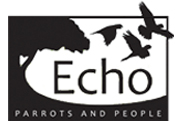 Have you ever wanted to get involved with conservation? Why not visit the Caribbean island of Bonaire and help rehabilitate illegally captured or injured Yellow-shouldered Amazon Parrots! This charismatic species is endangered in the wild and Echo, a small NGO with a dedicated team of conservationists, is working to protect them. Volunteering for Echo will involve living in a remote field camp and plenty of hard but extremely satisfying work. Volunteers will be given responsibilities for looking after captive birds and feeding released birds as well as opportunities to study wild parrots so a minimum of two weeks is required. If you fancy making a difference for
parrots and gaining many memorable experiences along the way, have a look at Echo's volunteer page. Have you ever wanted to get involved with conservation? Why not visit the Caribbean island of Bonaire and help rehabilitate illegally captured or injured Yellow-shouldered Amazon Parrots! This charismatic species is endangered in the wild and Echo, a small NGO with a dedicated team of conservationists, is working to protect them. Volunteering for Echo will involve living in a remote field camp and plenty of hard but extremely satisfying work. Volunteers will be given responsibilities for looking after captive birds and feeding released birds as well as opportunities to study wild parrots so a minimum of two weeks is required. If you fancy making a difference for
parrots and gaining many memorable experiences along the way, have a look at Echo's volunteer page. |
Events and Other Good Things
Creative people supporting parrots
|
Wild Parrots Up Close, Venezuela
Enjoy a spectacular parrot watching experience in Venezuela beginning with two weeks in the west followed by two weeks in the east and then a few days along the North Coast.
Join guide Steve Brookes for the whole month or any of the 2 weeks - both trips with very different itineraries to see Rose-crowned Conures as well as many more parrots, some of which are endemic to Venezuela.
There are 50 species of parrots, 103 Hummingbirds, 11 Trogons (of which 4 are Quetzals), 18 Toucans, Toucanets and Aracaris, 28 Woodpeckers and many more birds and mammals.
Date: Nov. 13 - Dec. 12, 2013
Location: Venezuela
Contact: steve@wildparrotsupclose.com
Learn more:
http://www.wildparrotsupclose.com
Wild Parrots Up Close, Australia
Let Steve Brookes take you on a journey initially to the South west from Perth, on to Tasmania and subsequently the Brisbane area, and not only are 16 species and sub-species of
Cockatoos possible but also several very rare parrots including the Orange-bellied Parrot and Ground Parrot amongst the target of 50 total species and sub-species of Cockatoos and parrots
he is aiming for on this adventure!
Date: Feb. 13 - Mar. 15, 2014
Location: Australia
Contact: steve@wildparrotsupclose.com
Learn more:
http://www.wildparrotsupclose.com
For more event listings, visit the WPT website at:
http://www.parrots.org/index.php/parrotnews/Events/
|
Want to submit a story?
We welcome contributed articles. For more information, please see our writer guidelines or contact us at flocktalk@worldparrottrust.org.
Want to reprint a story?
No material in this publication may be reproduced without permission from the World Parrot Trust. To request permission contact us at flocktalk@worldparrottrust.org.
Comments?
Please contact us at flocktalk@worldparrottrust.org.
Remember to add flocktalk@worldparrottrust.org to your address book or safe senders list.
|
|
Update your profile |
Forward to a friend |
Unsubscribe
WPT Online | Donate | Shop |
Privacy Policy | Disclaimer | Contact | About
|
|
© 2013 The World Parrot Trust | Glanmor House Hayle, Cornwall TR27 4HB
|
|



|
|








 Kris Porter specializes in enrichment for parrots, and is best known for her Parrot Enrichment Activity books, which she has made freely available to parrot caregivers for many years. Her books are full of photographs, suggestions and ideas to enrich the lives of parrots and promote activity rather than stillness.
Kris Porter specializes in enrichment for parrots, and is best known for her Parrot Enrichment Activity books, which she has made freely available to parrot caregivers for many years. Her books are full of photographs, suggestions and ideas to enrich the lives of parrots and promote activity rather than stillness.










 WPT is growing to meet the challenges of parrot conservation! We are pleased to welcome Dr. Rowan Martin to our staff. He will be the managing the WPT Africa Conservation Programme (WPT-ACP), a hefty job as he will be doing a great deal indeed: he'll be leading the development, management, and implementation of the programme, promoting its vision and objectives to external and WPT partners, and participating in strategic partnership-building and fundraising approaches, supervising WPT-ACP related projects, and providing technical assistance as required. Dr. Martin first became involved with WPT during his doctoral studies on the breeding behaviour of Yellow-shouldered Amazon parrots on Bonaire when he was based at the University of Sheffield, UK. Between 2009 and 2013 he held a Postdoctoral fellowship at the Percy FitzPatrick Institute of African Ornithology at the University of Cape Town, South Africa. While in South Africa he became involved in African parrot conservation, co-ordinating a review of the state of research and conservation in parrots in Africa for the International Ornithologist's Union Parrot Researcher's Group. The findings of this review provide a road map for the WPT Africa Conservation Programme.
WPT is growing to meet the challenges of parrot conservation! We are pleased to welcome Dr. Rowan Martin to our staff. He will be the managing the WPT Africa Conservation Programme (WPT-ACP), a hefty job as he will be doing a great deal indeed: he'll be leading the development, management, and implementation of the programme, promoting its vision and objectives to external and WPT partners, and participating in strategic partnership-building and fundraising approaches, supervising WPT-ACP related projects, and providing technical assistance as required. Dr. Martin first became involved with WPT during his doctoral studies on the breeding behaviour of Yellow-shouldered Amazon parrots on Bonaire when he was based at the University of Sheffield, UK. Between 2009 and 2013 he held a Postdoctoral fellowship at the Percy FitzPatrick Institute of African Ornithology at the University of Cape Town, South Africa. While in South Africa he became involved in African parrot conservation, co-ordinating a review of the state of research and conservation in parrots in Africa for the International Ornithologist's Union Parrot Researcher's Group. The findings of this review provide a road map for the WPT Africa Conservation Programme.
